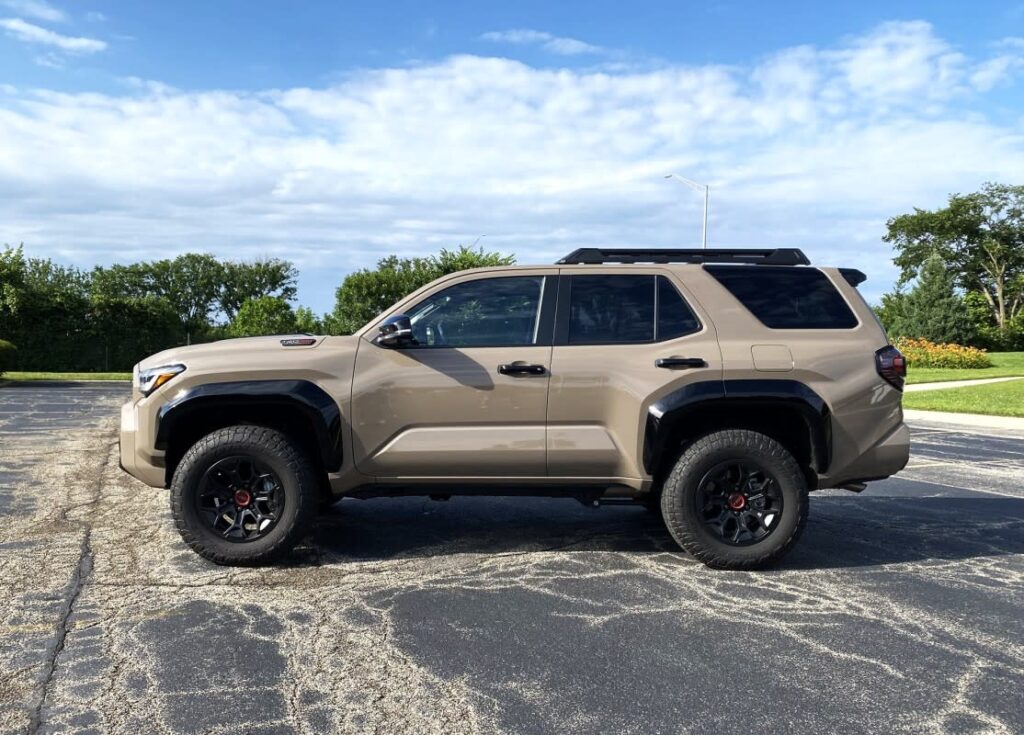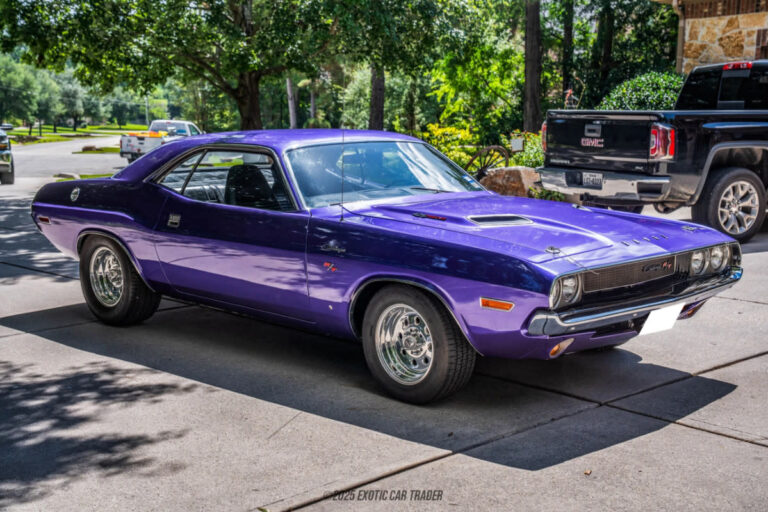
Take one look at the 2025 4Runner TRD Pro, and you can tell it means off-road business. Nothing about it looks remotely urban. All-terrain tires on matte black TRD wheels, a front skid plate, chunky black fender trim, a protruding hood intake, red tow hooks, an LED light bar, and a big roof rack all point to the 4Runner TRD Pro’s intentions to go off the beaten path and into the unknown. The 4Runner has finally been redesigned after sixteen long years, and it keeps its body-on-frame construction. When it comes to legitimate stock off-roading SUVs, there are a handful of players in the space: the Jeep Wrangler, Lexus GX, Ford Bronco, Land Rover Defender, and Toyota’s own Land Cruiser. Not to take away from the new Land Cruiser, but the 4Runner TRD Pro might be a tad more serious when it comes to the rough stuff.

When you wait over a decade and a half to redesign a vehicle, you had better upgrade pretty much everything. The new 4Runner ditches the antiquated 4.0-liter V6, replacing it with a more efficient and punchier turbocharged 2.4-liter four-cylinder engine paired with a hybrid system. In TRD Pro trim, it produces 326 horsepower and 465 lb-ft of torque—numbers that easily outmuscle the outgoing model. It sounds properly burly, not wheezy and high-pitched like other turbo-fours we’ve experienced. Our tester priced out at $73,568, including $1,450 delivery, processing, and handling. I spent a week behind the wheel, and here’s my unfiltered take.
The modern 4Runner has finally arrived
For years, the world waited far too long for a modernized 4Runner, and the new model finally brings a substantial redesign. At first glance, the TRD Pro looks unmistakably like a 4Runner: boxy profile, pronounced fender flares, and that all-important forward-canted C-pillar that all come together to lend that visual credibility. The 4Runner’s overall ethos shouldn’t be sacrificed in the name of redesign, and the new one pulls it off marvelously.

The slab doors have been replaced by ones with deeper sculpting, the fenders are more angular, and the front end has a newfound chunkiness that’s more cohesive with the rest of the body. The TRD Pro trim, as expected, goes all-in on off-road style, featuring heritage-inspired Toyota grille lettering, a standard roof rack, blacked-out trim, 33-inch all-terrain tires, and skid plates underneath. It also has some of the blockiest fender trim this side of a Kia Tasman.

View the 4 images of this gallery on the original article
Big, chunky, and plentiful physical controls


The matte and grippy plastics feel durable, and everything feels solid. If you’re looking for the interior polish of a Lexus LX, you’re barking up the wrong tree. This cabin is all about purpose-driven usage, surfaces that are mud and dirt-friendly but still look professional. The faux carbon fiber trim along the dash is interesting. It doesn’t look cheap, but it also doesn’t look like carbon fiber. The TRD Pro’s interior—red accents, SofTex-trimmed seats, and TRD badging—adds personality but doesn’t disguise its utilitarian nature.
Toyota made sure the 4Runner’s controls weren’t relegated to a digital experience. Everything is easy to grab and operate while driving, with knurled knobs, a tire tread relief-patterned grab bar, steering wheel controls, and tactile switches. The driver distractions endemic to touchscreen-only SUVs are, thankfully, minimized here because of the top-notch physical controls. No one wants to hunt for climate menus when hurtling down the highway in something this size.

View the 7 images of this gallery on the original article
Rear legroom is 34.8 inches, about two more than the old 4Runner, but a few inches shy of the Jeep Wrangler Unlimited. Tall passengers will feel a little cramped if the front occupants are six-footers. Thankfully, the second row reclines. Cargo space is pretty good. Hybrid models have 42.6 cubic feet behind the second row and 82.6 cubic feet with the second row folded. They give up about 8 cubes of total cargo space to the non-hybrid trims. We found it ample to throw in plenty of bags and sports gear. Small item storage is also goo,d with numerous door pockets and cubbies, as well as numerous compartments in the center console
The turbo four feels like a V6

Under the hood, Toyota finally retired the old V6, which only churned out 270 horsepower and was generally slow and unresponsive. The 5-speed automatic transmission’s slow downshifts didn’t help matters, requiring planning for freeway on-ramps and passing. All of that changes with the new 4Runner TRD Pro’s hybridized turbo-four and 8-speed transmission.
In real-world driving, the hybrid setup delivers strong low-end torque, making city driving and highway merging easy. Off the line, it feels quicker than any 4Runner before it. The gear shifts are smooth, though it can occasionally feel slightly hesitant when you demand sudden power at highway speeds. Gas mileage is better than the old 4Runner’s measly 17 mpg combined. We were able to get just over 20 mpg, and we dialed in Sport mode often. The 4Runner TRD Pro’s EPA estimate is 23 city/24 highway. With a lighter foot, we don’t doubt those numbers are attainable.

The 4Runner TRD Pro is no amateur

At the end of the day, there’s no mistaking that this is a body-on-frame SUV. It still drives like a truck, only smoother and a bit more civilized. It doesn’t feel like a chore to drive in everyday situations, and it’s more car-like than its predecessor, outranking a Jeep Wrangler hands down. Nevertheless, you know it has the guts to take on some real off-road challenges. Let’s just hope those who pay the extra coin for the TRD Pro trim ($26k more than the base SR5) actually take it to the woods, trails, and hills. There were no off-road parks more than a few hours from our location, so we had to settle for less challenging roads.

If you’re going to spend the money for the 4Runner TRD Pro’s standard features like Fox internal bypass shocks, an electronically locking rear differential, Stabilizer Disconnect System, Multi-Terrain Select, Crawl Control, and 9.5 inches of ground clearance, you had better do something with them. We’ve done our fair share of off-roading in Land Rover Range Rovers, Mercedes G-Classes, Jeep Wranglers, and even a Nissan Rogue Rock Creek. The 4Runner TRD Pro has the goods to rank near the Jeep Wrangler Rubicon, but won’t beat it because of the lack of a locking front differential. On the plus side, its Multi-Terrain Select is one of the best off-road drive mode programs on the market.
Final thoughts
The 2025 Toyota 4Runner TRD Pro is a massive improvement over the last generation. It’s more powerful, more efficient, safer, and more comfortable. Off-road capability remains its strongest asset, and loyalists will appreciate that Toyota didn’t soften its rugged identity. It is most definitely still recognizable as a 4Runner, and that’s a very good thing. If you rarely leave paved roads, don’t pay the premium for the TRD Pro’s capabilities. But if you want on-road comfort and daily drivability, combined with the ability to mount some serious trails on the weekend, this is your rig.
I Drove the 2025 Toyota 4Runner TRD Pro-Here’s My Brutally Honest Review














